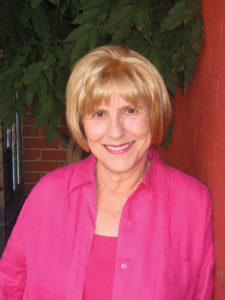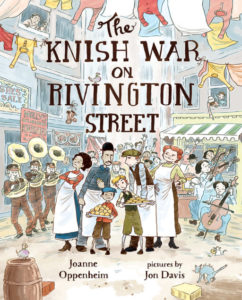I am delighted to introduce award-winning author, Joanne Oppenheim. Joanne has published over 50 books for children. The most recent is The Knish War on Riverton Street (Albert Whitman & Company), a charming and beautifully illustrated picture book about two families with competing knish bakeries. Illustrated by Jon Davis, The Knish War on Riverton Street is a PJ Library Selection 2017, Sydney Taylor Notable Book 2018, and received the Guides Association of NYC Apple Award for Outstanding Achievement in Fiction Book Writing 2018. Welcome, Joanne!
The Knish War on Rivington Street is based on a true event. Can you tell me how you found out about the event and what your process was for bringing the story to life for today’s young readers?
I found the story quite by accident, while researching another book on the Brooklyn Historical website. It was there that I noticed a program on the history of the knish, which struck me as funny. It also mentioned there would be knishes. That did it. In her program, Laura Silver, author of Knish, In Search of Jewish Soul Food, mentioned an article in the New York Times archives about a knish war in 1916. That too, struck me as funny. I mean, how do you have a knish war? As soon as I got home, I found the article online and knew at once— this was a picture book waiting to happen. Many of the events in my book come directly from that article, from the real competition between two knisheries that went to war.

Did you need to do any research for The Knish War on Rivington Street?
I had a lot of the information to start with but not how the knish war was settled. The New York Times reported the conflict with the funny headline, Knish War Heats Up. However, there was no follow-up story of how it cooled down. I never did find out how the knish war ended. That had to be made up. I also added the round vs square, baked vs fried conflict, since knish lovers generally have a strong preference and the “best” remains debatable. I searched for other accounts of the war and actually found several in a Baker’s Union newspaper, The Mediator, and even in Literary Digest magazine. Those articles gave me more information about the dispute. But, given the limitations of a picture book’s length, there were some delicious scenes that had to be left out. For example, there was an eating contest with knishes the size of small pies. It seems the winner ate twenty but had to be carried home. I was hard leaving that on the cutting room floor. It would have been a great illustration. But that’s the nature of researching—you often end up with too many goodies and choices have to be made.

What was your response when you first saw the illustrations by Jon Davis?
This was unusual. In the past, I have never seen illustrations in progress. Publishers notoriously do not connect author and illustrator. Traditionally they want two separate takes on the story. An editor of another book once told me that they “did not hire an artist to be my hands.” So this was a lovely experience! My editor at Whitman sent me the sketches as the books took shape and I saw the editorial notes and was welcome to add my own as the work progressed. I think it worked well and I was delighted with the final creation. Jon Davis has a wonderful sense of humor. It should also be noted that he did this without ever being in New York City or tasting a knish. He lives in England.
You have written numerous books for children, both fiction and non-fiction for varying ages. Do you have a favorite genre?
My first five books were written in verse. In fact, I wrote the Knish book in verse and then, at an editor’s request reworked it in prose. I still like the slightly sillier verse version. The happy part was being able to combine the prose with the rhymes. Combining the two has I don’t really have a favorite. I suppose, whatever I’m working on at the moment is my favorite. Right now, I’m working on a piece of historic fiction that has led to further adventures in research.
What is the best writing advice you ever received?
Learning how to “give up some of my golden words” as one editor called them, was and remains one of the tough lessons. I find it easier to save some of the cuts, knowing they can go back in. After a few days, I usually find the extras were “fool’s gold” that won’t be missed by anyone, including me. When I did the Knish book, I had a lot of rhymed signs that couldn’t fit into the book. I’ve had fun making posters with those signs for my website and telling readers what I found out about the historic locations on Rivington Street. All that “stuff” that couldn’t make it into a 32-page picture book. Someday, when they make the Knish War film (an animated feature, no doubt) my golden words will have their day to shine.
You might be amused with this story:
I happened to mention that I wished we could have recipes for making knishes at the end of the book. When PJ Library took the book, they loved that idea. We were about two weeks from going to press when the editor wrote to ask where were the recipes? I had foolishly assumed they would find recipes. I never made a knish is my life! Suddenly, I not only had to make them, I had to find recipes. After looking at many cookbooks and online, I found common elements and adapted them. However, I didn’t dare send them without trying them in my own kitchen. Maybe it was beginner’s luck, but they turned out to be delicious. Once again, I learned to be more careful about what I wish for…especially with editors.
Thank you, Joanne!
To learn more about Joanne and her wonderful books please visit her website: www.joanneoppenheim.com.